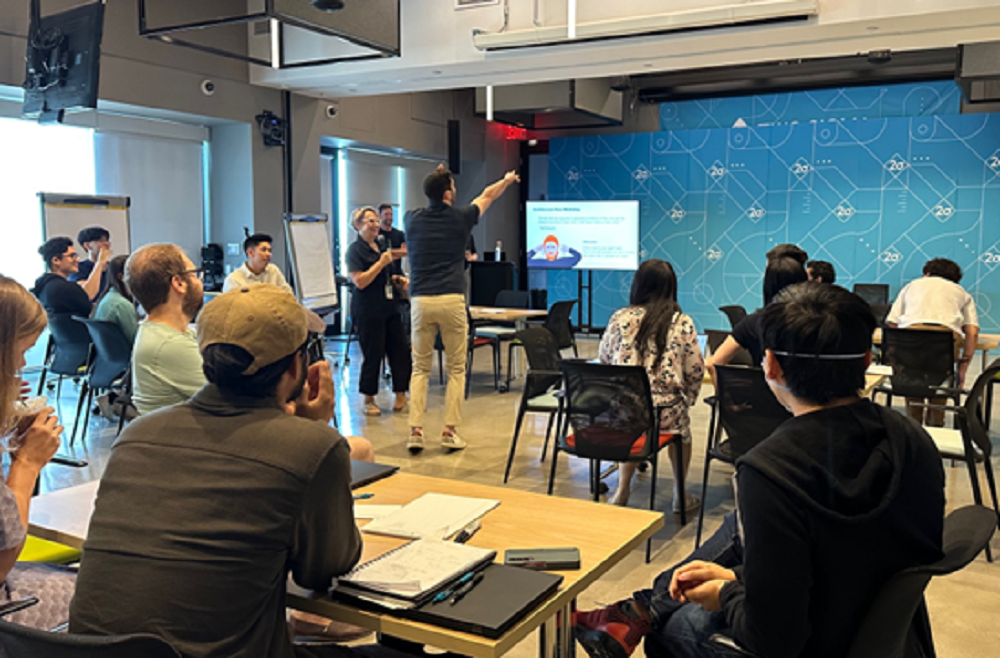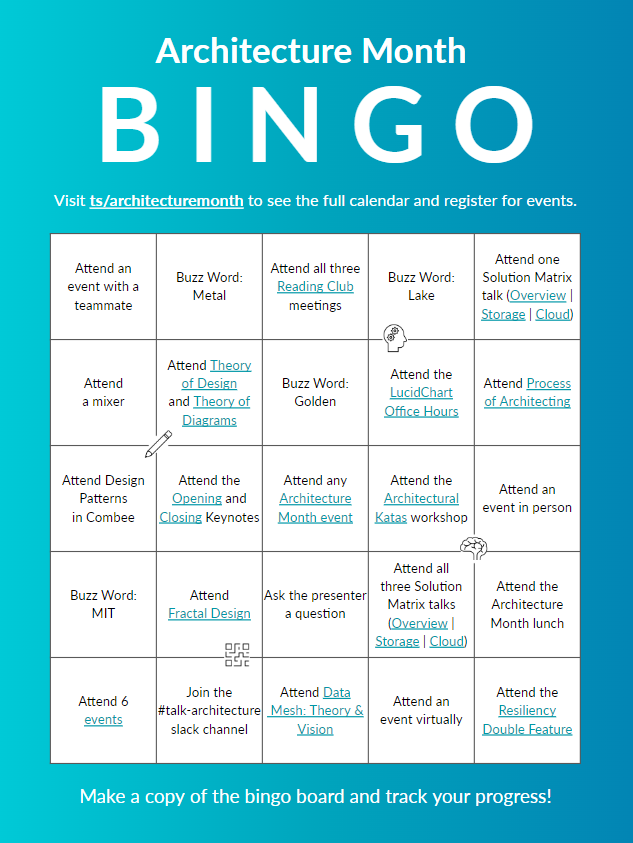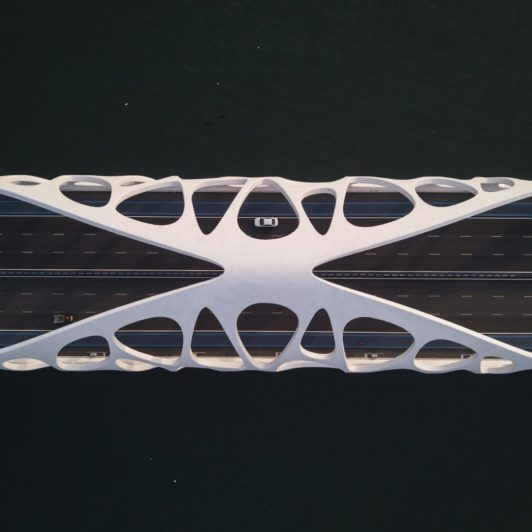July 2023 marked Architecture Month at Two Sigma, a series of live and virtual lectures and workshops (not to mention a few happy hours) intended to help the company’s software engineers move beyond writing algorithms to thinking about designing systems.
A broad collaboration involving the company’s Architecture, Data Engineering, and Engineering Education teams, the program proved hugely popular among participants, helped drive awareness and excitement around architecture, and offered valuable lessons on the challenges and benefits of organizing such a series.
Why focus on architecture?
Two Sigma has long prioritized building institutional proficiency in architecture. Legendary software developer Martin Fowler’s tongue-in-cheek definition of architecture itself suggests why this should be so: Architecture, he posits, is essentially “things that people perceive as hard to change.” It encompasses the decisions and approaches to building systems that are both critical to the systems’ overall functioning and difficult to reverse.
Put another way, software architecture represents the structure of software systems and their characteristics, and defines why and how individual software components interact with each other. As a result, it pays to get architecture right—and can hurt when you get it wrong.

Importantly, while Two Sigma does have senior group and area architects, as well as cross-functional architecture “x-teams,” architecture decisions here are federated, and not necessarily dictated from above. This means that even early-career engineers have a real opportunity to help ensure that the things they build integrate well with the broader systems of which they form a part.
…even early-career engineers have a real opportunity to help ensure that the things they build integrate well with the broader systems of which they form a part.
This opportunity is also a communal responsibility, however; using architectural principles as a framework for decision-making enables earlier-career engineers to deepen their knowledge and develop new skills in areas beyond their initial specializations. It can help engineers reduce the tendency to jump straight to execution when problem-solving, and instead adopt a more intentional, holistic approach. This organization-wide focus on architecture encourages engineers to dive more deeply into user requirements and better articulate a system’s purpose. Finally, it gives engineers the opportunity to practice architecting on a continuous basis. After all, as Ted Neward has noted, “…How are we supposed to get great architects, if they only get the chance to architect fewer than a half-dozen times in their career?”
The opportunities associated with this approach extend beyond those for engineers themselves, of course. Two Sigma’s emphasis on architecture is also a means for the company to cultivate, over time, a large cadre of developers who are trained to think systemically from the outset, thus helping to lay the foundation for the company’s future success.
Developing a meaningful curriculum
With these concepts and motivations in mind, the organizers of Architecture Month developed a program that centered around two main themes:
- Theory of Design explored the foundational philosophies and methodologies involved in building resilient systems. Participants heard from both internal and external experts in the field.
- Two Sigma Practices examined the practical application of these theoretical concepts in the particular context of Two Sigma. These talks were given by internal experts.
The content for 2023’s Architecture Month centered around data architectures, including storage design, although much of the material covered applies equally well to other engineering subfields. Attendees were able to participate in a wide range of offerings, including:
- Architecture Kata—A workshop where engineers could practice design thinking through hands-on exercises.
- Theory of Design—A talk on how to reason about architecture while building it, with an emphasis on common tradeoffs and architectural patterns.
- Solution Matrix—A Two Sigma framework for innovation and standardization, intended to provide guidance to the question, “I have an idea. How do I build it?” This framework promotes experimentation and allows for local preferences, while helping to prevent the proliferation of solutions to a single problem. Sessions included an overview and separate deep-dives into storage and cloud solution matrices.
- Theory of Diagrams—MIT’s Dr. Michael Trice spoke at our New York offices on how to create clearer system diagrams that demonstrate the potential of a design and actively communicate with a reader or viewer.
- Fractal Design—Observations on understanding, interacting with, and simplifying complex architectures from Two Sigma’s head of Foundational Data Engineering.1
- Process of Architecting—A detailed look at the job of an architect, highlighting the importance of communication, collaboration, and company culture.
- Did we already mention Architecture happy hours? Engineers gathered in our New York and Houston offices after some of the talks over drinks and bites to spend time with engineers on different teams, and to discuss what they learned and how to apply new ideas in their work.2
- Last but not least, Architecture Month bingo, which ran for the duration of the program. Designed by one the organizers to encourage people to attend a wide selection of events, winners received bragging rights and architecture-themed prizes. Grand prize winners received a Lego architecture kit of the NYC skyline, while base-level winners won a smaller Lego set.

Key learnings
Approximately a quarter of the company’s engineers—along with a number of summer interns—participated in 2023’s Architecture Month. Additionally, the process of architecting (sic) the program will feed into the development of future iterations, though they will focus on different sub-themes.
“[Developing the program] was harder than we thought it would be,” said Scott Rich, Two Sigma’s head of architecture and one of the event’s organizers, “but it was worth it.” In addition to raising the overall level of proficiency in architecture among the company’s engineering teams, he noted, there were plenty of ancillary benefits.
For example, the process of designing more than 20 discrete talks and workshops left Two Sigma’s engineering organization with a substantial repository of reference material for our ever-expanding knowledge base, and precipitated significant updates to a variety of product and process documentation.
Architecture month changed the way I design software…
For the engineers who attended, the program also provided valuable opportunities to connect with colleagues and learn more about the trade-offs their colleagues make in the designing of systems. This knowledge-sharing will lead to increased collaboration and help both fuel and satisfy the endlessly curious nature of Two Sigma’s engineers.
“Architecture month changed the way I design software,” reported Wei Luo, an early-career engineer on the Instrument Models team. “It gave me in-depth perspectives into a wide breadth of architecture design philosophies and techniques at Two Sigma, ranging from distributed storage to collaborative diagramming. For example, the diagramming tools allow me to collaborate with my teammates more seamlessly during the design process. I’m also inspired to think more often about design trade-offs to achieve a balanced result that suits the use case.”
Interested in learning more about engineering at Two Sigma? Stop by our Careers page and get to know us better!






